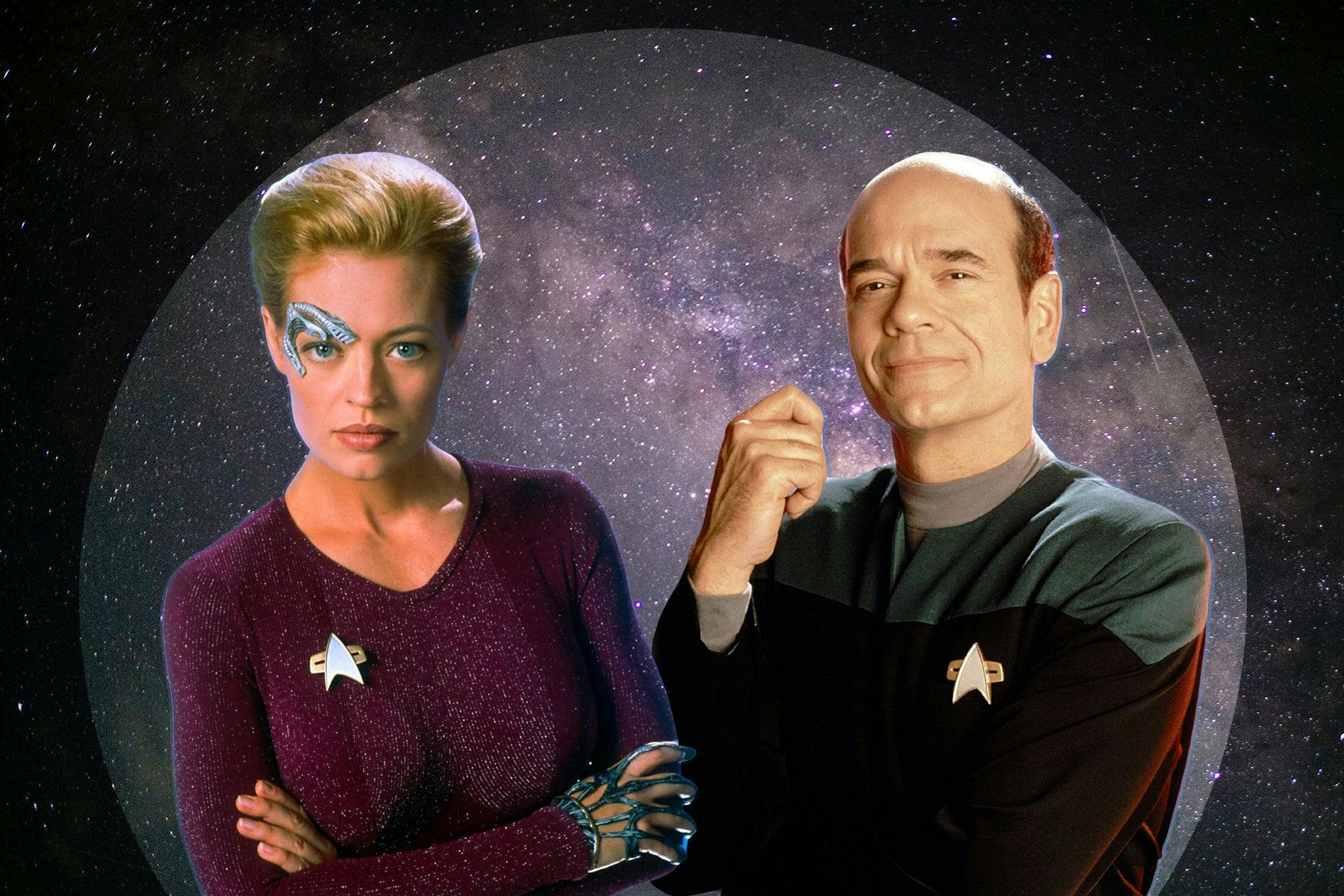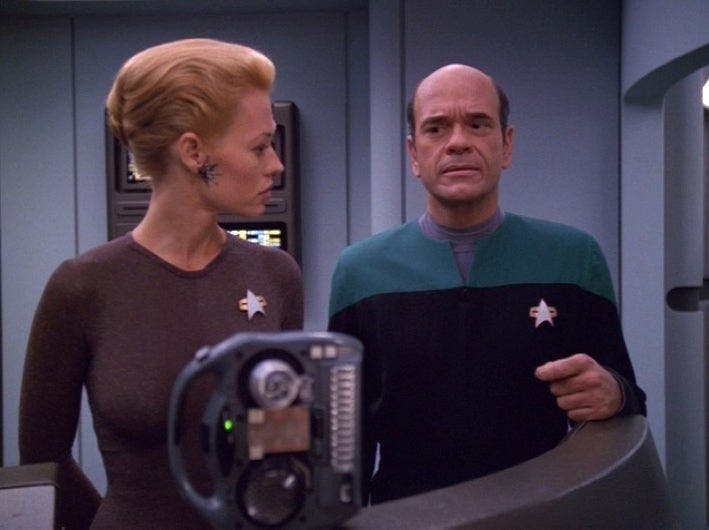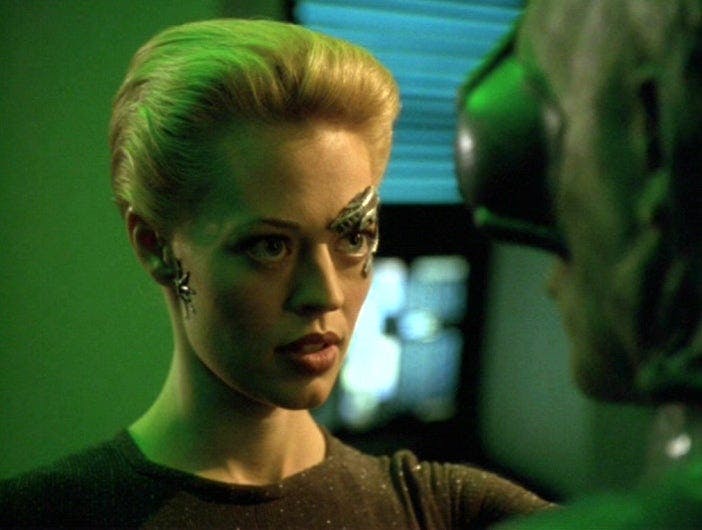Published Mar 6, 2019
Dynamic Duos: Seven of Nine and The Doctor
Author Mary Fan considers how The Doctor and Seven of Nine compelled Trek fans to ask, "What makes us human?"

StarTrek.com
One of the many things that makes Star Trek special is its willingness and ability to explore complex emotions and relationships against a science-fiction backdrop. In fact, the franchise often takes it a step further by weaving sci-fi elements into these very human stories — which are made all the more interesting when the participants aren’t actually human.
The relationship on Star Trek: Voyager between The Doctor (Robert Picardo), a sentient hologram, and Seven of Nine (Jeri Ryan), a cyborg, is fascinating and wonderful on many levels. Both are rooted in humanity. The Doctor was originally a virtual copy of his human creator, Dr. Zimmerman, and Seven of Nine was born human and then assimilated into the Borg collective as a child. And both exhibit many human traits, even as the world or even they themselves deny their own humanity.

StarTrek.com
It’s intriguing — almost ironic — that their relationship begins with an artificial being helping a woman reclaim the humanity that was stolen from her. The Doctor literally removes Seven’s Borg implants, extracting those parts of her that had suppressed her humanity for so long. However, he’s unable to completely return her to an organic state, as some of the Borg technology has become so integrated into her body that removing them would have killed her.
This parallels her personality; she’s now an individual and not part of the Borg collective, and yet being essentially raised by the Borg has impacted her personality and the way she interacts with the world. Even after her escape, the Borg have forever shaped her, inside and out — something that’s metaphorically acknowledged in her decision to remain “Seven of Nine,” her Borg designation, rather than reclaiming her human name, Annika Hansen.

StarTrek.com
Meanwhile, throughout the series, The Doctor is constantly working to improve his own humanity, adding subroutines and exploring new dimensions of himself. In fact, his desire to help Seven rediscover her humanity through social lessons is, in a sense, him projecting his desires on to her. This is made the most apparent in the episode “Body and Soul,” where he inhabits her body and indulges in the physical sensations he can’t experience as a hologram, most notably by overeating (and giving Seven the mother of all stomachaches). Though she (understandably) objects, she comes to appreciate his perspective that eating can be for pleasure, and not just as a way of refueling.
The Doctor is arguably the first one to appreciate just how dynamic a person Seven can be. Through their social lessons, they both discover elements of her that were previously buried. While Seven explores her identity, the Doctor eventually falls in love with her, adding a new level of complication to their relationship. Especially since his feelings are not requited.
It’s rare, truly rare, in any media to see a close emotional relationship between a man and a woman that doesn’t end with a mutual romance. It’s become expected that if a man and a woman are depicted as being so close that they’ll eventually fall for each other and live happily ever after (or at least want to until circumstances rip them apart). Yet, unrequited love between friends is something that happens in the real world. While it may not be as satisfying to watch, it’s certainly worth exploring through storytelling.

StarTrek.com
I, for one, appreciated that Seven and the Doctor did not end up in a romantic relationship, even though that seemed like the obvious conclusion to their story. It made their friendship far more interesting, especially since they remained friends even after Seven made it clear that she wasn’t romantically interested in the Doctor (who was crestfallen). I also appreciated that Seven didn’t take offense when she glimpsed the Doctor’s daydreams about her via the holodeck; she acknowledged that these were only fantasies and trusted him enough to know that they wouldn’t impact their interactions. The mutual respect they show for each other throughout this sticky emotional situation is admirable.
Picardo and Ryan did an absolutely phenomenal job of bringing these two complex characters to life, and making their interactions ring so true. Picardo’s combination of irritability, dry humor, wit and slight insecurity made him truly believable as a person always trying to better himself, while Ryan’s ability to display cold intelligence while hinting at the vulnerability beneath is what makes Seven such a compelling character. It couldn’t have been easy to bring all the layers of the Doctor and Seven’s evolving relationship to life on screen, and both actors managed it with charm and subtlety.

StarTrek.com
Like all good teachers, The Doctor eventually has to acknowledge that Seven has outgrown him. What started out as social lessons evolves into a true friendship, complicated by romantic tensions, that survives several fraught circumstances. And along the way, we, the audience, are invited to ask questions about what makes us human as we watch two non-humans figure it out.
Mary Fan is a sci-fi/fantasy writer hailing from Jersey City, NJ. She is the author of the Jane Colt sci-fi series, which comprises Artificial Absolutes (2013), Synthetic Illusions (2014), and Virtual Shadows (2015), and Starswept (2017), and Flynn Nightsider and the Edge of Evil (2018), a YA dark fantasy and the first novel of the Flynn Nightsider series. Due out in 2019 is Stronger Than a Bronze Dragon, a YA steampunk fantasy. Check out her official page at www.maryfan.com/.

